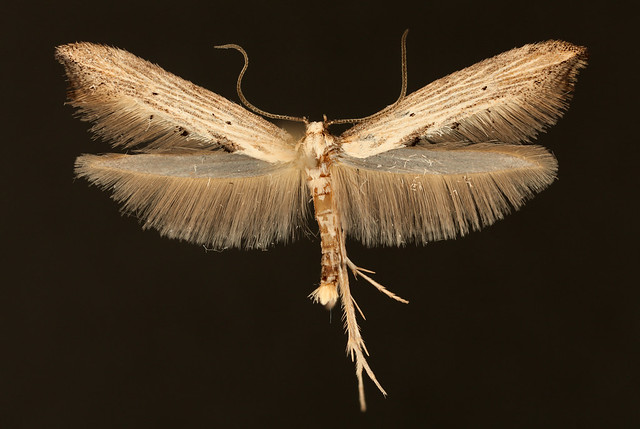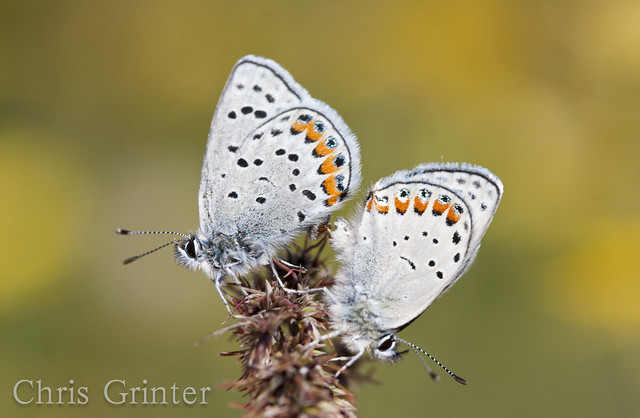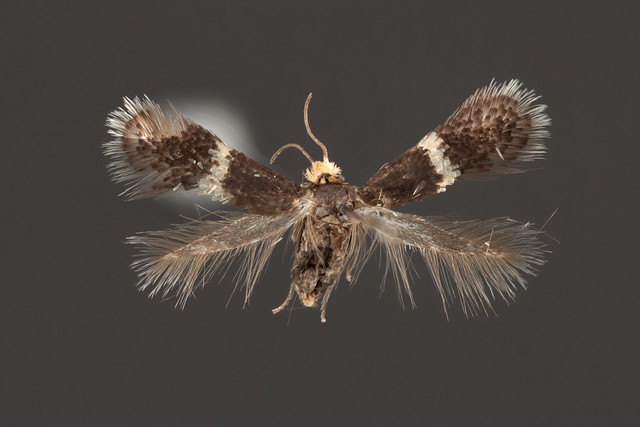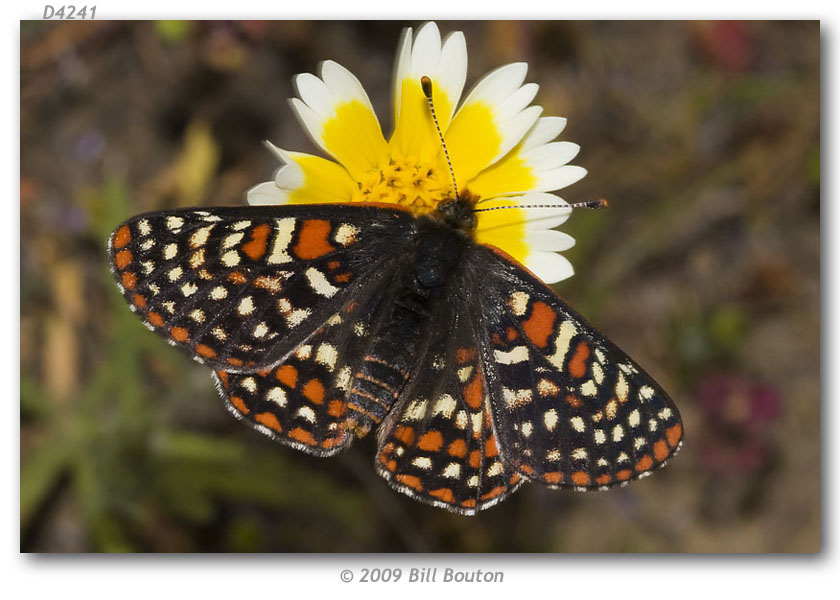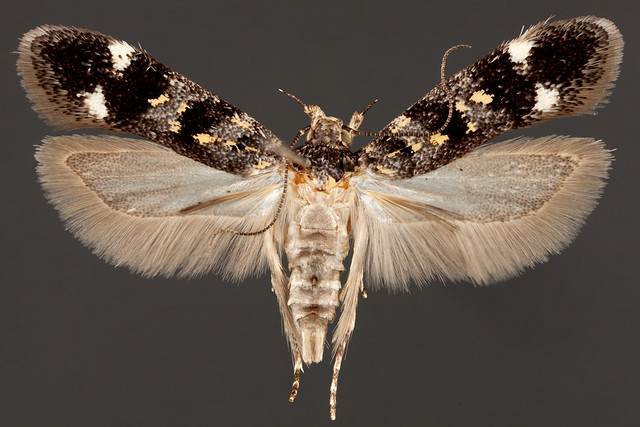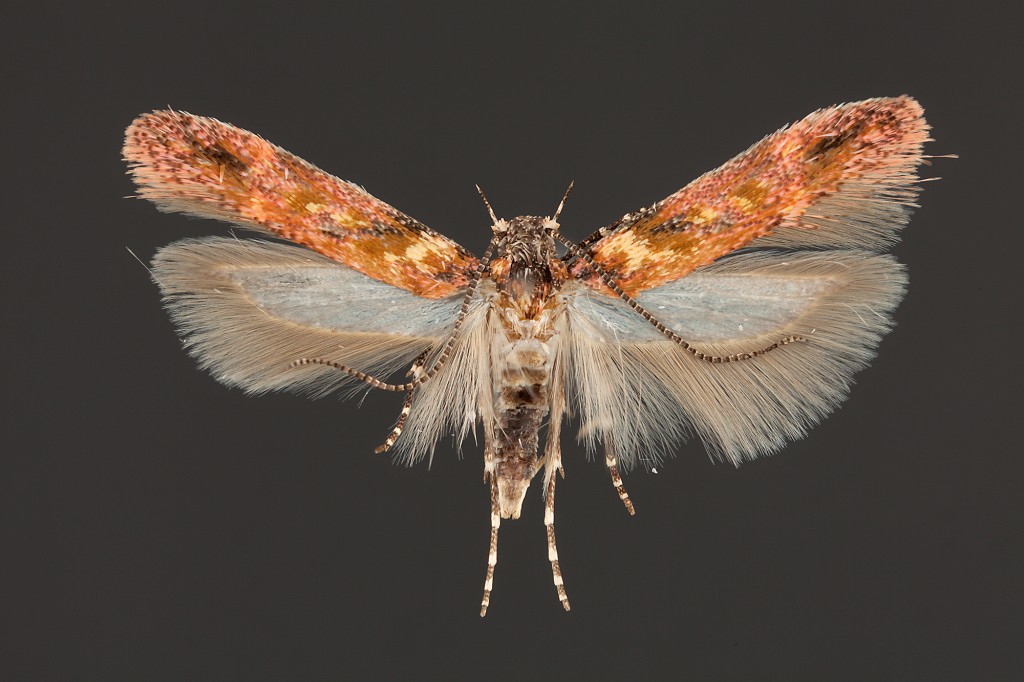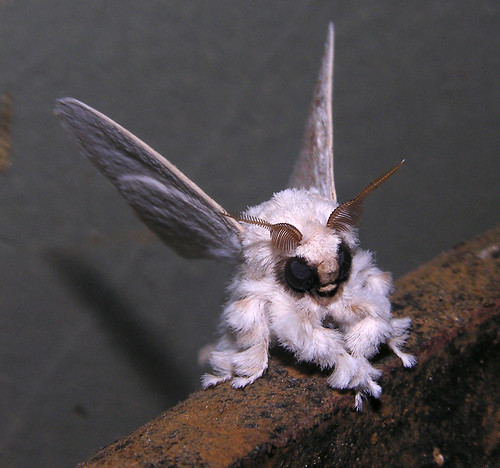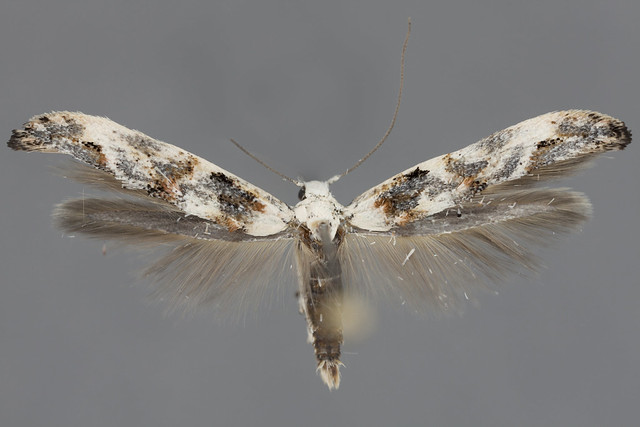დღევანდელ moth არის ლამაზი სახეობის კლდოვანი მთები გარეთ Denver, ეპერმენია სტოლიდოტა (Epermeniidae). ეს არის რეალურად უფრო დიდი ნიმუში, ვიდრე ეს, როგორც ჩანს,, შესახებ 20mm from wingtip to wingtip. იმ დააყენა, ჩაბნელებული, tufts of scales on the posterior edge of the forewing is a great character for this family, as well as the stiff bristles on the hind tibia (also somewhat visible here). Არიან, იმყოფებიან 11 species in 2 genera in the United States, with likely a few more to be discovered. Fellow curatorial assistant David Bettman keyed this species out using the revision of the Nearctic species: PDF here.
|
ამ კვირაში მე გაზიარების პატარა, ჭუჭყიანი, and semi-competently spread Nepticulidae in the genus სტიგმელა from the same light trap of Prescott Arizona as the past few Monday Moths. მე, როგორც წესი არ იზიარებს ფოტო moth, რომელიც არ არის საუკეთესო მდგომარეობაში, but I’m using this as an example of technique. Not only was this 4mm moth pulled out of the bottom of a light trap, but it was field pinned and dried for over a year and a half. I’ve always heard that it can nearly be impossible to deal with the smallest of the small; and for the most part I haven’t. I used to think you need to capture them off of a light sheet alive in a vial and euthanize moments before spreading, all while never, ever let them dry the tiniest bit beforehand. But as it turns out, you can get away with a decent specimen by relaxing 24 hours and spreading upside down. Of course if you have a perfectly fresh specimen that avoided the blender of a bucket-trap it would make for a far superior specimen. Better yet, you pulled the leaf mine and reared the moth yourself. Most of these Nepticulidae are host-specific and far more diverse than we have given them credit. I’ve heard there could be at least 100 new species awaiting discovery in the US alone. ამბავი მრავალი San Francisco პეპლები ცნობილი და დამთრგუნველი. სფეროში მძიმედ იმოქმედა ადამიანის განვითარების ბოლო ორი საუკუნის განმავლობაში და არის სამარცხვინო სახლში პირველი ცნობილი მაგალითია გადაშენდა ამერიკული პეპელა, The Xerces blue. მიუხედავად იმისა, რომ სხვა პეპელა ჰკიდია, or getting help to hang on like the მისია Blue, some like the Bay Checkerspot have continued to decline despite valiant efforts for reintroduction. დღეს, the only known colony of the Bay Checkerspot is within Santa Clara County on a site called Coyote Ridge. It was twenty one years of intensive study of the checkerspot in the 1960’s and 70’s by the famous biologist Paul Ehrlich that provided the impetus for federal listing in 1987. Როგორც 1998 the colonies he studied have since gone extinct. Here is an excerpt from a 1980 paper in the Journal of the Lepidopterists’ საზოგადოება “Two California Checkerspot Butterfly Species, One New, One on the Verge of Extinction” (.pdf).
All efforts to relocate this butterfly have failed, and the future of this animal is not looking bright. And so what exactly is this creatures name? In 1937 Robert F. Sternitzky described what he thought to be an overlooked San Francisco butterfly “Euphydryas editha var. bayensis“. Those early descriptions of variations and races are roughly equivalent to today’s subspecies – and so the butterfly remained bayensis for decades and became a mascot for conservation. But where was the very first Euphydras editha from and how did the San Francisco bayensis differ? Unfortunately the original description is vague and the collecting locality is simply listed as “California”, as was the unfortunate habit of Boisduval who described the butterfly 1852. But all hope is not lost since the famous French Lepidopterist was having specimens sent to him by the earliest California Lepidopterist, Pierre Joseph Michel Lorquin. An eager gold prospector and butterfly collector, Lorquin traveled California from 1849 რომ 1858 and again in 1869. Every butterfly that was sent back to France was a new species and subsequently described by Boisduval – who of course named one of California’s most beautiful butterflies after Lorquin. Enter Emmel, Emmel and Mattoon in 1994 who were writing the Systematics of Western North American Butterflies. In the process of cleaning up the mess of these early western species they had to designate a Lectotype for ე. editha editha since Boisduval never fixed a Holotype in 1852. Essentially he named a new species without designating the taxonomic standard for the group, making future work ambiguous for taxonomists. Thankfully the travels of Lorquin have roughly been documented and we can ascertain that he should have been in San Francisco around 1849. Comparisons of the original specimens to the Bay Checkerspot made for an overwhelming case that it was this butterfly that was sent to France in the 19th century. The result of this finding therefore places the Bay Checkerspot Euphydryas editha bayensis into synonymy with the older name Euphydryas editha editha. The name bayensis effectively dissappeared because it was a re-description of a butterfly that was already known. Euphydryas e. editha as it turns out has been known from coastal California from the bay region down to San Luis Obispo – and so voila, the range of the Bay Checkerspot just exploded. But of course the story isn’t that simple and the butterfly didn’t become magically safe with a name change. Conservation groups and ecologist kicked and screamed and refused to accept the change, even the Xerces Society hasn’t jumped on board with the consensus of taxonomists out of what I can only assume is fear of the appearance that their butterfly is no longer endangered. I’ll emphasize that this doesn’t mean that the populations in the bay are no longer threatened – there is still a need for protecting these biologically significant populations as they are significantly declining. Habitats all throughout the region are facing ongoing and pernicious threats (pdf). All in all the name change is trivial, we can now call the Edith’s Checkerspot the Bay Checkerspot, and still fight to protect this butterfly. I’m unsure of what would be required to amend the federal register, and if it’s at all possible to expand protection of an animal like this without re-petitioning the endangered species act. So perhaps I can understand the failure to embrace the name change since from the outside it looks like their bug is no longer endangered. Მეორეს მხრივ, this could bring attention to populations of a butterfly that have been overlooked for decades.
Many thanks to John Pelham for conferring with me over this taxonomic headache.
რაც შეეხება სხვა დაუდგენელ Gelechiidae-ს იგივე ადგილიდან, როგორც წინა ნიმუში (არა. პრესკოტი არიზონა). მე ვიღებ დანას ამ ჩრჩილის გვარში ყოფნისას ქიონოდები – და ის ზედაპირულად ჰგავს სახეობას გ. გააგრძელე. საბედნიეროდ არის ამ ჯგუფის მონოგრაფია (ამერიკის თხემები მექსიკის ჩრდილოეთით, ფაციკული 7.6) და მე შევძლებ გაკვეთას და იმედია მივაღწევ უკეთეს იდენტიფიკაციას. თითების სასქესო ორგანოები საოცრად სკლეროტიზებული სტრუქტურებია, რომლებსაც შეუძლიათ იდენტიფიკაციისთვის გამოყენებული სიმბოლოების სიმდიდრე.. აუცილებლად უნდა გავაზიარო მალე სასქესო ორგანოების სურათები!
This moth is a good example of what a lot of my moths are at the moment – unidentified! This is certainly a Gelechiidae, you can see the large upturned palps on the front of the head, and a finger-shaped projection on the tips of the hindwings. Just about one of the easiest families of microleps to identify. And from a general gestalt perhaps this is in the Gnorimoschemini? If someone recognizes this little guy please let me know, otherwise I’ll attack the literature to try and track down the name. This beautiful moth is from the mountains outside of Prescott, AZ – ივლისი 2010. Rather enjoyably, there are so many microlepidoptera that are not easily identified. თქვენ შეიძლება უკვე გსმენიათ შოკისმომგვრელი ამბების შესახებ მოსალოდნელი ცვლილებები ბუნებრივი ისტორიის საველე მუზეუმში ჩიკაგოში. მოკლედ, მუზეუმი ფინანსურ კრიზისშია და მასიური ცვლილებები განხორციელდება ახალი პრეზიდენტის მიერ, რიჩარდ ლარივიერი. სავარაუდოა, რომ კვლევითი პერსონალის ნახევარზე მეტია (მათ შორის დაუფიქრებელი კურატორები) განთავისუფლდება და ყველა კვლევითი დეპარტამენტი დაიშლება “მეცნიერება და განათლება”. ფული დახარჯავს ექსპონატების მოდერნიზაციას, ყველა მუზეუმის სამეცნიერო ბირთვის ღილაკს. გთხოვთ, ერთი წუთით მოაწეროთ ხელი ამ შუამდგომლობას და გამოთქვათ თქვენი შეშფოთება: დაიცავით კვლევები საველე მუზეუმშირამდენიმე თვის წინ, ბევრი თქვენგანი ალბათ stumbled მასშტაბით ამ meme – ცნობილი Poodle Moth! და მართლაც რომ დიდი ნაწილი ანალიზის იყო ნახევარი ღირსეული. დიახ, ეს რეალური. დიახ, ეს moth. დიახ, ეს ალბათ სახეობების Lasiocampidae (შესაძლოა გვარი არტასი) როგორც სწორად აღნიშნა Dr. ჯონ როულინსი. ველოდი, რომ ეს ყველაფერი კარგად და კარგად იქნებოდა, ჰეი, არსებობს უამრავი საყვარელი თითი და დროა ვინმემ შეამჩნიოს! მე არ შევწუხდი სტატიის წაკითხვამდე, სანამ კოლეგამ არ გადმომიგზავნა იგი “კოსმოსური შესვლა nbcnews.com-ზე“. რაც ვიპოვე იყო არანაირი რეალური ზიანი, მაგრამ მთელი ეს კრიპტოზოოლოგია მაბრაზებს. ვფიქრობ, სამწუხაროა, რომ კრიპტოზოოლოგმა ამდენი საჯაროობა მოიპოვა და მასზე საკმაოდ სანდოობით ისაუბრეს. კრიპტოზოოლოგია არის არა მეცნიერება, არც იქნება ოდესმე. როდესაც კრიპტოზოოლოგია ტარდება როგორც მეცნიერება, მას ბიოლოგია ეწოდება. დიახ, არიან თხილები, რომლებსაც სჯერათ, რომ ისინი ატარებენ ნამდვილ მეცნიერებას, წრეებში მაღალი ზღაპრების მიყოლა და ანეკდოტების წყობის აგება “მტკიცებულება” რომელიც, როგორც ჩანს, არასოდეს იწვევს ჭეშმარიტებას. არსებობს რეალური განსხვავებები იმას შორის, რასაც აკეთებს მეცნიერი და ფსევდომეცნიერი. თქვით, რომ მეცნიერი ისმენს ცნობებს უცნაური ცხოველის შესახებ, რომელიც ცხოვრობს ღრმა ჯუნგლებში – ისინი მიდიან ექსპედიციაში (დაფინანსების მოთხოვნის შემდეგ) ადგილობრივი ისტორიების შეგროვება და ჯუნგლებში ლაშქრობა ან ოკეანეებში ჩაძირვა ნიმუშების მოსაძებნად მძიმე სამუშაოს შესასრულებლად. მერე სახლში მოაქვთ ეგ ნიმუშები, ყოველი დეტალის ამოკვეთა, და შედეგები გამოაქვეყნეთ რეცენზირებად ჟურნალში. თუ ნიმუშები არ იქნა ნაპოვნი, მაშინ ეს მეცნიერი სახლში ხელცარიელი მიდის და ხელახლა განიხილავს ამ ახალი მითიური არსების შესაძლებლობას.. შესაძლოა მეტი დაფინანსება მათ მეტ დროს მისცემდა ამ სფეროში… (ყოველთვის პასუხი, მარჯვენა?) მაგრამ ამბავი აქ მთავრდება, მტკიცებულების გარეშე ცხოველი არ არსებობს. სწორედ აქ შორდება კრიპტოზოოლოგია რეალურ მეცნიერებას – ისინი იგებენ ანეკდოტურ ზღაპრებს, როგორც ფაქტს და არასოდეს აღიარებენ დამარცხებას. ნესი არსებობს იმიტომ, რომ ხალხი იხილეთ მას. ახსნა არ შეიძლება იყოს უფრო სარწმუნო ვარიანტების დიდი მასივი… რადგან სამყარო, რომელშიც კრიპტოზოოლოგი ცხოვრობს, მითიურია და ფუნდამენტურად არარეალურია. OK საკმარისი ranting, მოდით ვიმედოვნებთ, რომ ახალი ამბების ციკლში უფრო საყვარელი თითები მოხვდებიან! დღევანდელი თითი არის განსაცვიფრებელი მიკრო და კიდევ ერთი არსება ბარბ ბარტელის უკანა ეზოდან კლდოვან მთებში. რამდენადაც ვიცი, ეს არის სახეობა მომფა (კოლეოფორიდები), ალბათ კლაუდიელა,მაგრამ მე ჯერ არ მაქვს დადებითი ID ამ შეცდომაზე. როგორც კი დავიწყებ ამ საიტიდან მიკრობების გათხრას, აუცილებლად იქნება სიურპრიზები! |
სკეპტიციზმის |
